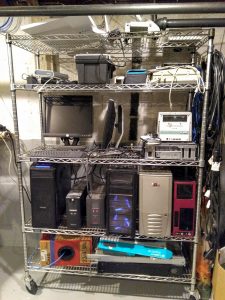
For years I have maintained my own Linux servers at home running Fedora with KVM. Each server is a pretty beefy AMD machine with as many processor cores and as much memory as I could afford. On each, I set up a few development servers for both .net development and running MS SQL Server. I still have all of them. Only two (the black gaming cases) are currently running, but If I want to go back and do some development on Windows 2003. I can just fire up that pink box and I’m off to the races.
There are tons of advantages to running your own servers. The first is that you know how to set-up servers and you can use all those licenses in your MSDN subscription. The second is that you can say things like KVM, network bridge, QEMU and not sound like a doofus. I can go on about the cool factor of running your own virtual host, but most of it doesn’t really matter. The main reason to have servers is that you are not developing on your desktop.
Your work lives in a protected environment away from your email and video gaming. Windows 10 now likes to reboot quite a bit and I hate being interrupted. You can tell a server to never reboot and it will listen to you. I could leave Visual Studio up for weeks at a time and always come right back to where I was last working.
The downside to all this is the growing junk collection and having to maintain it all. I would love it if I could set up a server on Azure and just do my work there. I already use their source control and production hosting services. Having it all there would be nice as long as it doesn’t cost me an arm and a leg.
Over the course of the next few weeks, I am going to be exploring what it takes to use Visual Studio on Azure, how well it works for web development and how expensive it can be.